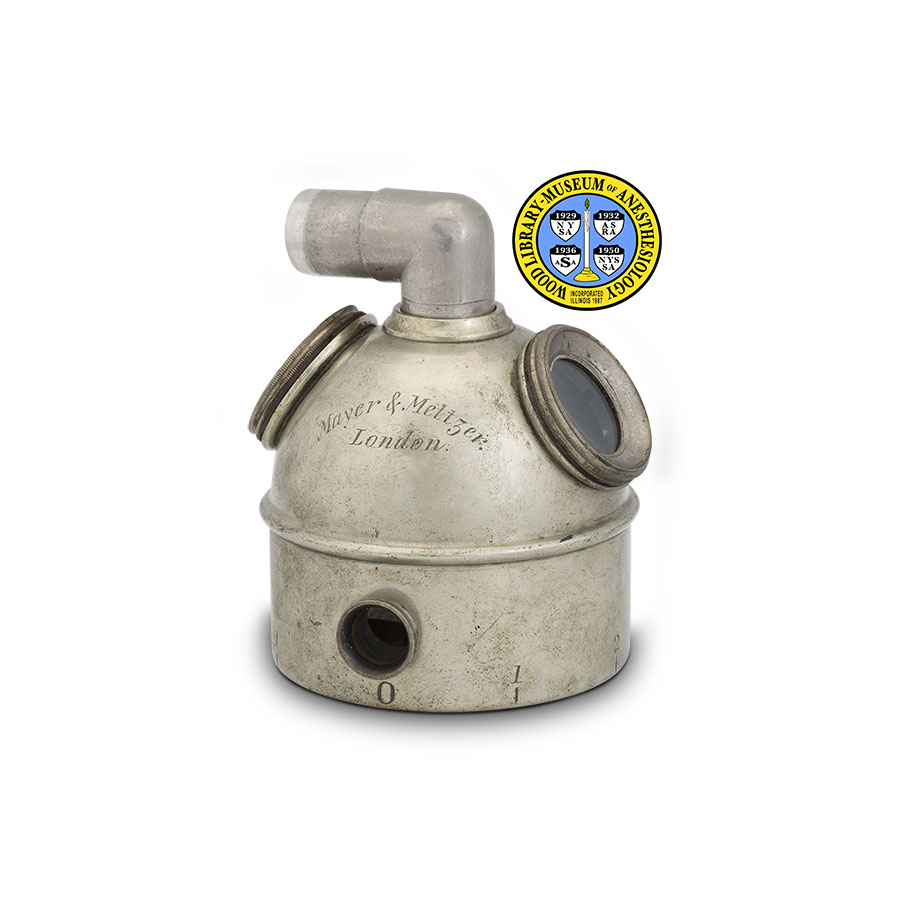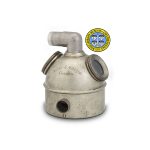Wilson Smith Inhaler
The English physician, T. Wilson Smith (born ca. 1868), introduced his ether inhaler in 1898. It was patented by the manufacturer, Mayer & Meltzer, and was still available in 1931. The example shown here is incomplete. It was one of many modifications of the Portable Regulating Inhaler, introduced in 1877 by Joseph Clover (1825-1882.) Like Clover's, Wilson Smith's inhaler had an interior water bath to keep the ether warm, and a dial that controlled the amount of fresh air that was admitted. His most noticeable modification was a pair of glass windows that allowed the anesthesiologist to see the level of the ether remaining inside. The windows could be removed, so that the interior could be cleaned. There was a more important change, inside. Wilson Smith's inhaler had a wide-bore air passage, for better air flow. This had first been suggested in 1847 by John Snow (1813-1858). The same principle was used again a few years later, in the Wide-Bore Inhaler invented by Sir Frederic William Hewitt (1857-1916).
Catalog Record: Wilson Smith Inhaler Wilson Smith Inhaler
Access Key: apop
Accession No.: 1939-10-11-1 A
Title: [Wilson Smith inhaler] / Mayer & Meltzer.
Author: Wilson Smith, T., born ca. 1868.
Corporate Author: Mayer & Meltzer.
Title variation: Alt Title
Title: Aseptic Inhaler.
Title variation: Alt Title
Title: Modified Clover Inhaler.
Title variation: Alt Title
Title: Modification of Clover’s Inhaler.
Publisher: London : Mayer & Meltzer, [between 1898 and 1919].
Physical Description: 1 inhaler ; metals, glass, rubber, 12 x 12 dia. cm.
Subject: Anesthesia, Inhalation – instrumentation.
Subject: Ether, Ethyl.
Subject: Inhalers, Anesthesia – Great Britain.
Note Type: General
Notes: The title is based on several sources. The inventor introduced his invention as a “Modified Clover’s Inhaler”. The manufacturer’s 1899 catalog called it “Aseptic Clover’s Inhaler (M & M’s patent) designed by Dr. Wilson Smith”. In the index of the 1899 catalog, it is listed as “Smith, Wilson, Inhaler”. The manufacturer’s 1931 catalog called it “Wilson Smith’s Modification of Clover’s Ether Inhaler”.
First year in the date range is the year that the inhaler was introduced by the inventor. The second year in the date range is the year that the manufacturer’s name changed.
The object is described from the patient’s perspective. In this orientation, the manufacturer’s name, and the number “0”, face the viewer. This accords with the manufacturer’s illustration, which shows the inflatable face mask oriented with the “nose” directly under the “0”, with the fill tube on the opposite side of the mask (roughly over the patient’s chin).
Note Type: Citation
Notes: British Medical Journal. Reports and analyses and descriptions of new inventions in medicine, surgery, dietetics and the allied sciences. British Medical Journal. November 12, 1898;2(1976):1500-1502.
Note Type: Citation
Notes: Galley AH, King AC. Modifications of the Clover’s ether inhaler.” Anaesthesia. December, 1948;3(4):147-153.
Note Type: Citation
Notes: Mayer EW, inventor. Improved ether inhaler. UK patent 6012, November 29, 1898.
Note Type: Citation
Notes: Mayer and Meltzer. A Catalogue of Surgical Instruments and Hospital Requirements Manufactured and Sold by Mayer & Meltzer. London: Mayer & Meltzer, 1899:450.
Note Type: Citation
Notes: Mayer and Phelps. An Illustrated Catalogue of Surgical Instruments and Appliances Manufactured and Sold by Mayer & Phelps. London: Mayer and Phelps, 1931:495.
Note Type: Citation
Notes: Miller AH. Technical development of gas anesthesia. Anesthesiology. July, 1941; 2(4):398-409.
Note Type: Citation
Notes: Thomas KB. The Development of Anaesthetic Apparatus. Oxford: Blackwell Scientific Publications, 1975:22-26.
Note Type: Physical Description
Notes: One ether inhaler; The body of the inhaler is divided by a ring into two unequal portions; The upper portion is dome-shaped, and holds two removable, round windows and a removable elbow connector; The height of the inhaler without the elbow connector is approximately 10.5 centimeters; The diameter without the connector is approximately 10.5 centimeters; The front of the dome is marked in cursive script: “Mayer & Meltzer [new line] London”; The back of the dome is marked “PATENT [new line] Rd. No. 312,303”; These marks are centered between the windows;
The opening of each window is approximately 3.5 centimeters in diameter; Each of these openings is closed with a screw cap that holds a slightly concave glass lens; Each of the window caps is approximately 4 centimeters in diameter; The rubber gasket of each screw cap is in poor condition; The round opening that holds the elbow connector is approximately 2.25 centimeters in diameter; This distal end of the elbow would have held a rubber rebreathing bag (missing from this object);
The lower portion of the inhaler has two round openings; One is located on the front, and is approximately 1.5 centimeters in diameter; This is an aperture for filling the ether chamber, and would be closed with a rubber stopper (missing in this object); The second opening is located directly opposite the first, and is approximately 1.25 centimeters in diameter; This is the aperture for filling the interior water jacket that surrounds the ether chamber; This second opening closes with a screw cap, approximately 2.25 centimeters in diameter; The lower portion of the inhaler is marked along its lower edge, from left to right: “3, 2, 1, 0, 1, 2, 3”; The flat base of the inhaler has a round opening in the center, approximately 2.5 centimeters in diameter; This opening would have held a metal fitting that consisted of an indicator dial and a connector for a mask (both missing from the cataloged object.
Note Type: Reproduction
Notes: Photographed by Mr. Steve Donisch, November 15, 2016.
Note Type: Acquisition
Notes: Gift of the Australian Society of Anaesthetists.
Note Type: Historical
Notes: The English physician, Joseph Clover (1825-1882), introduced his Portable Regulating Ether Inhaler in 1877. It remained in production through the 1930s, and inspired a number of modifications, including the Hewitt Wide-Bore Inhaler. Dr. T. Wilson Smith (born ca. 1868) introduced his own modification of it in 1898. Galley and King (p. 147) state the he was a general practitioner in Bath, England, and was 80 years of age in 1948. Dr. Wilson Smith also introduced a modification of the Silk inhaler, in 1904.
The principal new features of Wilson Smith’s modification of the Clover Inhaler are its wide-bore air passage, its removable windows and its breathing bag. Each of the two glass windows is mounted in a cap that screws on and off, to facilitate cleaning of the inhaler. The breathing bag had a valved cap at that end opposite to the inhaler, which could be adjusted to add more fresh air. (The same bag cap was also a feature of Wilson Smith’s later modification of the Silk Inhaler.) Galley and King explain that the wide-bore concept was first introduced in 1847 by John Snow (1813-1858). Snow had recommended that the interior bore be equal or greater in size to the human trachea, to enable the free flow of air. They note that it was reintroduced in 1901 by Frederik William Hewitt (1858-1916), without reference to the work of Wilson Smith.
The manufacturer did business under the name Mayer & Meltzer from 1863 to 1919, when the name became Mayer & Phelps. The WLM owns two of this company’s catalogs, dated 1899 and 1931, respectively. The Wilson Smith Inhaler appears in both of these. The 1931 Mayer & Phelps catalog includes many of the same illustrations that were used in Mayer & Meltzer’s 1899 catalog, including that of the Wilson Smith Inhaler. This illustration differs from the cataloged object in the text and location of some of the markings. The partnership of Mayer, Phelps and Jackson, in Melbourne, Australia, advertised in the Australian Journal of Dentistry in 1905. The latter may have been the source of the cataloged object, which was donated to the WLM by the Australian Society of Anaesthetists.
Note Type: Publication
Notes: Wilson Smith, T. Medical Annual, 17th ed., 1899. (Cited in Galley and King, p. 153.)
Note Type: Exhibition
Notes: Selected for the WLM website.


